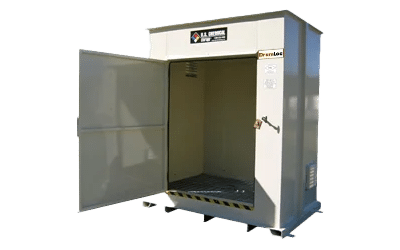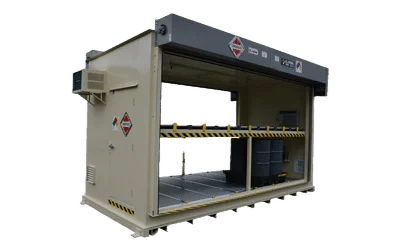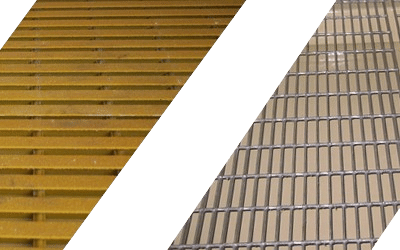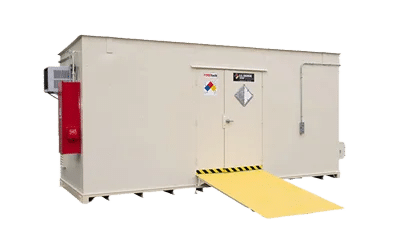Drum Storage Buildings
Safely contain hazardous material drums with a DrumLoc™ drum storage building from U.S. Chemical Storage. Whether storing palletized drums or single drums of chemicals, our 100% customizable drum storage buildings provide unmatched safety and security while complying with all regulations.

*DrumLoc storage buildings
Drum Storage Buildings
Safely contain hazardous material drums with a DrumLoc™ drum storage building from U.S. Chemical Storage. Whether storing palletized drums or single drums of chemicals, our 100% customizable drum storage buildings provide unmatched safety and security while complying with all regulations.
As our most trusted and used product, DrumLoc drum storage buildings deliver more than just a storage solution. Allowing your team to safety store chemical drums on-site or in easy reach helps improve efficiencies in your manufacturing processes. While non-fire rated construction designed for storing chemical drums when located at least 30-feet from any occupied structure or property line* is standard, all DrumLoc™ buildings can be modified for 2- and 4-hour fire ratings if required. Our buildings are manufactured using the highest quality steel making them durable enough to withstand fluctuations in weather and environment.
Safely Store 55-Gallon Chemical Drums
Like all U.S. Chemical Storage buildings, drum storage buildings can be manufactured to FM standards and come with an industry-leading 15-year structural warranty. Standard features include a continuously-welded, leak-tested secondary spill containment sump, a static grounding system, and acrylic alkyd enamel coating. You can customize your building based on your specific chemical drum storage needs. Popular optional accessories include temperature controls, drum crane hoist systems, access ramps, racking systems, mechanical ventilation and more.
*Always consult your local authority with jurisdiction to ensure that all rules and regulations are followed, including proper setback requirements.
Types of Drum Storage
Palletized Drum Storage
For palletized drum storage, use our non-occupancy building design style. These units provide full-face swing or roll-up style doors for convenient forklift access to each side of the container. It also prevents workers from entering a potentially dangerous environment. Units are available in one to four bays, with economical stational racking systems or optional convenient push-back racking for maximum storage capacity and flexibility. Store up to 48 palletized loads (192 drums); modular storage buildings are available for larger storage requirements.
Single Drums and Small Container Storage
Keep mixed single drums of hazardous chemicals away from your facility but accessible to workers with walk-in style drum storage buildings. Double doors allow personnel entrance and egress with a drum dolly while opening to full width for larger equipment and pallet placement. These drum storage buildings are suitable for isolating hazardous processes as well as mixing and dispensing operations. Customize further with optional ramps, shelving and partition walls. Store up to 100 single drums or multiple large containers; modular buildings are available for larger storage requirements.
Features & Benefits
- 100% customizable
- Durable steel construction
- Acrylic alkyd enamel with epoxy paint upgrade available
- 15-year structural warranty
- EPA compliant spill containment sump
- Mixing and dispensing rooms available
- Modular solutions available for larger footprints
Common Applications
- Drum storage
Frequently Asked Questions
First consult the Safety Data Sheet (SDS) to determine the type of chemical you’re storing and any storage requirements listed. There are two main classifications of buildings to consider: fire-rated and non-fire-rated steel buildings. There are three main questions you should answer before engineering or design can begin on your building: what is to be stored, how much of it is being stored, and where is the location it will be stored? You will also need to consult with your local “Authority Having Jurisdiction” (AHJ) or local code expert to determine your area’s specific storage building requirements. Our team at U.S. Chemical Storage has a wealth of knowledge, experience, and resources to help analyze your storage needs, but the final approval is made by the local AHJ, so you will need to ultimately ask them about your requirements early in the planning process.
The definition of a “sump” is a pit or reservoir providing containment for spilled liquids. U.S. Chemical Storage offers leak-proof spill containment sumps in each standard model. All our sumps are tested for leaks for a 24-hour period prior to finishing. The sump is then covered by a steel or fiberglass floor grating and can even be equipped with a resistant plastic sump liner to protect against corrosive chemical accidental spills. The size of the sump is dictated by code based on the volume of liquid being stored within the building.
Start by speaking with one of our experienced Technical Sales Engineers to learn about the needs of your application. They will want to know what type of chemicals you are storing? How much of it will you be storing? What proximity to other buildings, people, egress paths, or environmental features will it need to be? Do you require special spill containment? And from there they’ll ask any related questions that determine additional options; Material Handling – Climate Control – Ventilation – Occupancy – Lights – Sensors – Alarms – Door Styles – Eyewash Stations and other requirements are not uncommon. Answers to these questions will dictate the building’s fire rating construction as well as anything else you’ll need for proper code compliance.
Request a Quote
RELATED PRODUCTS
DrumLoc™ Chemical Drum Storage Buildings
DrumLoc™ is a safe and secure non fire-rated storage building and provides ideal protection for large quantities of hazardous chemicals. View >Chemical Storage Building Doors
Doors are the first line of defense when protecting your chemical assets and preventing accidents; we offer a variety of door systems. View >Flooring
Finding the right flooring for your chemical storage building is easy with the many U.S. Chemical Storage options.
View > Access
Ramps
Access ramps are available with all buildings to allow for convenience when loading or unloading chemicals.
View > 
YOUR PARTNER IN THE PROCESS. EXPERIENCE YOU CAN TRUST.
We deliver the precise building solution with the speed, security, and high quality that you demand.




